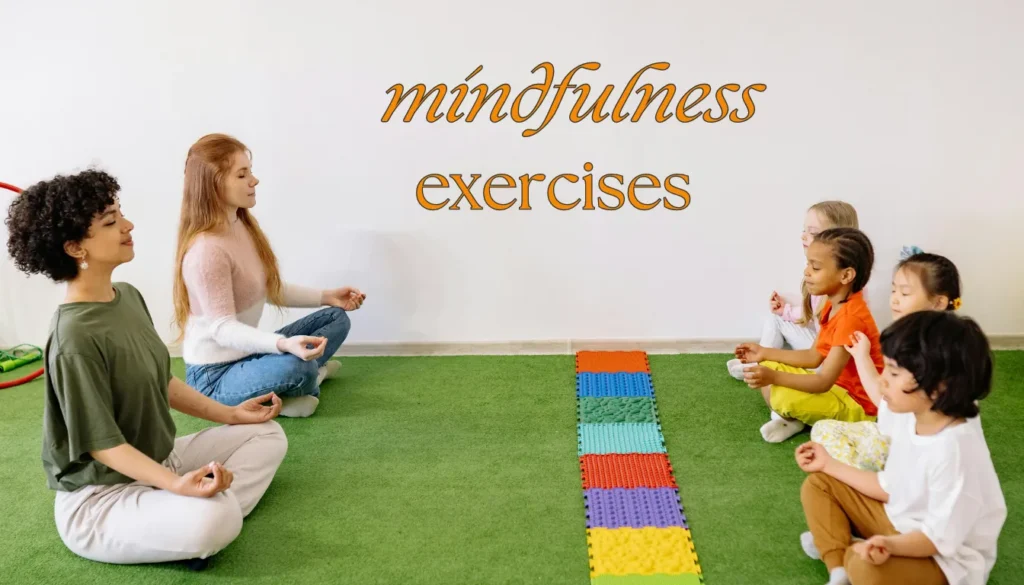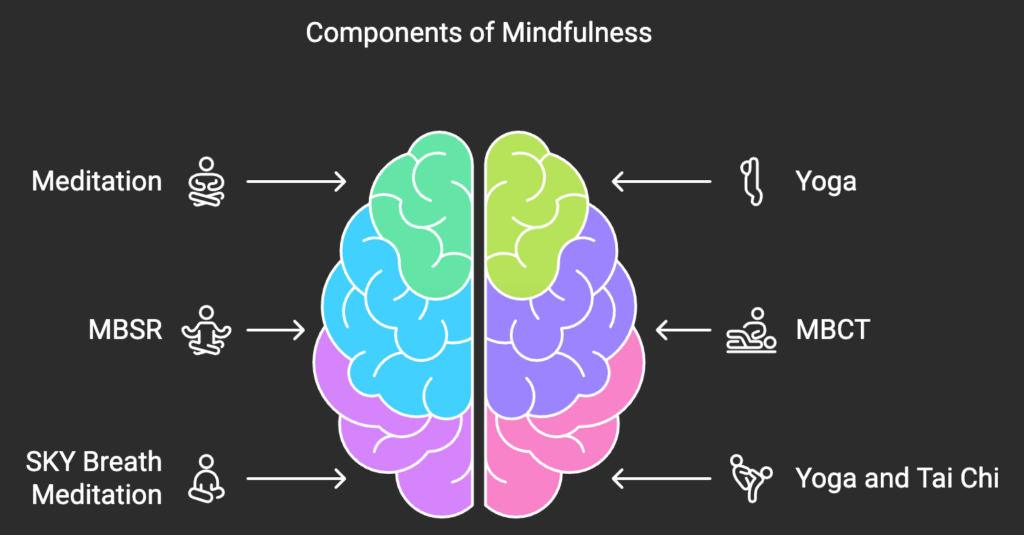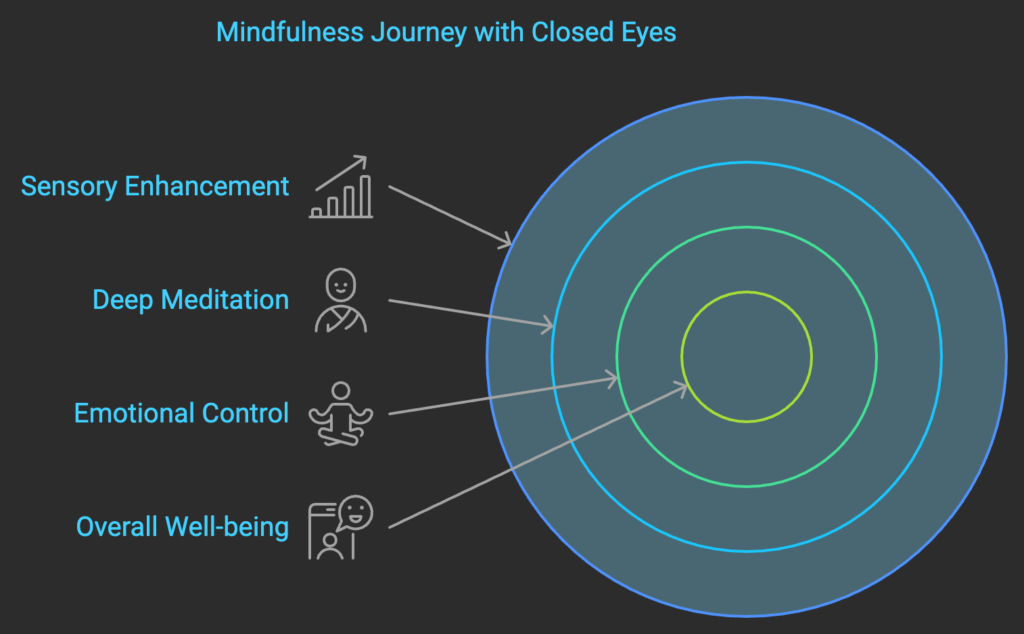In our rushed world, mindfulness stands as a calm beacon. My own life shows how mindfulness can truly change us. Through exercises like guided meditation, I found the clarity and focus I once missed.
Mindfulness is backed by science, not just a passing craze. For instance, neurobiologist Daniel J. Siegal explains how it boosts our brain’s executive functions. These include emotional intelligence and success in academics. Students grow like seeds in fertile ground, learning trust and cooperation.
Parents tell me of the positive changes they see in their kids. After meditation and yoga, their children become more focused and curious in learning.
Mindfulness is more than sitting quietly. It enhances life by improving creativity, problem-solving, and empathy. I’ve heard students talk about feeling calm in chaos thanks to mindfulness. This approach changes classrooms, making learning an exciting adventure.

This article points to ten unique mindfulness exercises. They promise to transform education and more. These simple practices boost mental clarity and self-control, as noted by scientists.
No matter your experience with meditation, these exercises promise to enrich your moments. They range from calming breaths to the Body Scan for mental and physical health. Let’s start a journey focused on being fully present and embracing mindfulness in every aspect of life.
The Impact of Mindfulness on ADHD and Academic Success
I’ve looked into how mindfulness can change the lives of students with ADHD and boost their school achievements. The well-known neurobiologist Daniel J. Siegal points out that mindfulness exercises for stress relief do more than just ease stress. They are vital for improving the thinking skills needed for doing well in school. Let’s explore how mindfulness not only eases ADHD symptoms but also helps with school performance.

Mindfulness has been shown to improve significant problems linked with ADHD, like poor attention and difficulty with planning and doing tasks. When students practice mindfulness every day, they get better at focusing, remembering things, and being aware of themselves. These are critical skills for succeeding in school.
Research highlights a GRE score improvement of 16% at the University of California, Santa Barbara after mindfulness training. Also, studies show that mindfulness greatly lowers the stress that comes with schoolwork. This makes it an essential tool for students dealing with the challenges of their studies.
| Benefit | Description |
|---|---|
| Improved Focus and Concentration | Enhances attention span essential for academic tasks. |
| Enhanced Memory Retention | Provides techniques for calming the mind, which is crucial during exams and presentations. |
| Reduced Anxiety and Stress | Provides techniques for calming the mind, crucial during exams and presentations. |
| Better Emotional and Social Intelligence | Improves interactions and collaborations in academic settings. |
Following Daniel J. Siegal’s teachings, mindfulness tools don’t just help with ADHD. They also make the whole school experience better. By creating an environment where students can do well both emotionally and in their studies, mindfulness shows its importance in education today.
By making mindfulness a daily habit for students, we can change not only their school results but also build a better, more caring school community. This approach helps those with ADHD and all students, making academia more welcoming and supportive for everyone.
Benefits of Mindfulness in the Classroom
Adding mindfulness exercises to classroom settings brings big changes. I’ve seen students work better together, and the mood of the room improves. These activities help them in school and life, giving them important skills.

Building Trust and Support Among Students
Mindfulness exercises are great for creating a supportive environment. They help students work together and improve how they get along. A study of 207 research papers found these exercises can boost academic scores by 11% and social skills by 25%.
Enhancing Creativity and Problem Solving
Creative mindfulness activities open up students’ creativity and problem-solving. This calm focus boosts their ability to think outside the box. It turns learning into something fun and active.
Improving Emotional Regulation and Focus
Mindfulness in schools helps students control their emotions and focus. It’s really good for handling stress and anxiety. This means they can concentrate better and stay calm, even during tough times. Research shows that mindfulness increases blood flow in the brain, which helps with paying attention and managing feelings.
The perks of mindfulness in schooling are wide-ranging. They include better grades, improved social skills, and stronger mental health. Teachers also benefit from easier classroom management and less stress. Using mindfulness in education helps students face challenges and learn important life skills.
Integrating Mindful Practices into Education
Mindfulness exercises are key for students’ learning and mental health. Teachers can introduce these methods in many ways, boosting school performance and well-being.
Setting the Stage for Mindfulness through Literature
Texts on mindfulness show students its value. They learn its importance and benefits for personal and academic growth. Books and theory discussions prepare them to engage deeply.
Incorporating Daily Yoga and Meditation Routines
Adding mindful breathing, yoga, and meditation to daily school routines helps students develop calmness. This makes mindfulness a regular part of their lives, not just an occasional activity.
Creating Peaceful Classroom Environments
Creating a calming space is essential for practicing mindfulness. Adjusting the classroom with music, lighting, and soothing scents supports this. It makes the environment suitable for stress relief exercises.
Analyzing techniques shows how mindfulness improves education. Here’s a look at different methods and their benefits:
| Technique | Description | Benefits |
|---|---|---|
| Deep belly breathing | Using 3-second inhale and exhale patterns | Calms mind and body, enhances focus |
| Sensory experience jars | Creating jars with familiar smells | Increases focus and relaxation |
| Guided imagery journeys | Pretend travels through space or underwater | Boosts imagination, integrates learning |
| Yoga and movement | Connecting poses to learning topics | Encourages self-expression, builds confidence |
| Journaling and Listening | Mindful reflections and active listening exercises | Improves communication, helps emotion management |
Mindfulness for beginners enhances education and life skills. These tools prepare students for the challenges of life. Educators thus foster a resilient, mindful generation.
Unlocking the Benefits of Mindfulness Beyond Meditation
Meditation is often seen as the main part of mindfulness. But mindfulness is much bigger than that. There are many tools that can make our lives better. This includes simple practices like yoga and more detailed methods like MBSR and MBCT.

Mindfulness isn’t just sitting quietly by yourself. It fits into different parts of life, improving our mental well-being. It helps us deal with stress and get along better with others. By practicing mindfulness, even for a short time, we can get more organized and do better at work.
Mindfulness doesn’t just help us feel better. It can actually change our brains. Studies show it can make parts of the brain bigger, which helps us remember things better. This is an excellent reason to make mindfulness part of our everyday life. It makes us brighter and happier.
| Method | Benefits | Duration and Frequency |
|---|---|---|
| MBSR (Mindfulness-Based Stress Reduction) | Reduces stress, anxiety, and negative thoughts | 8-week course, 30-45 min daily practice |
| MBCT (Mindfulness-Based Cognitive Therapy) | Decreases depressive symptoms, prevents relapse | Structured sessions with periodic practice |
| SKY Breath Meditation | Reduces stress, enhances focus and memory | Varies, frequent sessions recommended |
| Yoga and Tai Chi | Improves balance, flexibility, and mental peace | Regular classes or practice as preferred |
Looking at different mindfulness tools shows they do more than just reduce stress. They change the way we see ourselves and the world. This leads to a stronger and happier life. Mindfulness tools, like MBSR, MBCT, and SKY breath meditation, prepare us for the challenges of our busy lives.
Mindfulness Techniques for Improved Mental Clarity
Starting a mindfulness journey can transform your mental clarity. It helps melt away stress and boosts well-being. Mindfulness exercises for anxiety make big shifts in how we think and feel possible. Studies show these methods improve mental health and life’s quality.
To begin fostering mindfulness, start with simple exercises. These can lead to more profound self-exploration. Here are some effective exercises to improve mental clarity:
- The Candle Study Exercise: Focus on a candle flame for 5 to 10 minutes. It’s great for boosting concentration and being present.
- The Berry Challenge: Eat a strawberry slowly, for 30 to 60 seconds. It enhances your sense of taste and moment-to-moment awareness.
- The Gratitude List Exercise: Write down 5 to 10 things you’re thankful for each day. It promotes a positive outlook and keeps you grounded.
- The Introspection Exercise: Spend a quiet moment to observe your thoughts and feelings. It fosters self-awareness and curiosity about your mental state.
- The Morning Pages: Write three pages of your thoughts first thing in the morning. It clears your mind and readies you for the day.
- The Foot Grounding Exercise: Focus on feeling your feet on the ground and breathe mindfully. It helps stabilize you during anxious moments.
Using these mindfulness techniques sharpens mental clarity and lays the foundation for a mindfulness lifestyle. Seeing mindfulness as a journey lets continuous practice become a key part of your life. This practice leads to facing daily challenges with resilience and calm. Benefits include less anxiety and depression, better sleep, and increased life satisfaction.
Embracing the Quality of Presence
Practices like focusing on your breath or body scans teach lasting presence. They help you leave behind past and future worries. Being present cuts down distractions and connects you deeply with the now. This connection is key for clear thinking.
Mindfulness as a Mindset: The Ongoing Journey
The mindfulness path offers ongoing discovery about our thoughts, feelings, and reactions. It’s about growing and learning continuously, not reaching a final goal. Mindfulness eases chronic condition symptoms and boosts everyday life. It’s a lifelong ally for better mental and emotional well-being.
Mindfulness Exercises for Attention and Observation
Participating in mindfulness exercises improves our mental clarity and focus. These activities are based on Dr. Amishi Jha’s research. She is a neuroscientist and professor at the University of Miami. Dr. Jha’s studies in her book “Peak Mind” show how 12 minutes a day can sharpen our attention.
Integrating mindfulness into our day is easy and doesn’t take much time. The exercises are short, making them easy to fit into our busy lives. Dr. Jha has created exercises that last three minutes and improve our focus and memory.
Dr. Jha believes attention helps us connect better with others and be more compassionate. Exercises like observing an apple or a ring for five minutes help us notice details calmly and without judgment.
Here’s a summary of a typical mindfulness session by Dr. Jha:
| Phase | Activity | Duration | Focus |
|---|---|---|---|
| 1 | Slow breathing | 2 minutes | Induces relaxation, releases muscle tension |
| 2 | Observation | 5 minutes | Reflect on the experience for a deeper understanding |
| 3 | Documentation | 3 minutes | Observing selected objects with non-judgmental awareness |
| 4 | Reflection | 2 minutes | Reflect on the experience for deeper understanding |
Mindfulness helps reduce stress and increases our focus and compassion. These techniques make it easier to concentrate in busy times. They also help us feel more connected to the present. Everyone can benefit from adding these practices to their life.
Slow Living: A Pathway to Mindfulness
Slow living has opened my eyes to the powerful benefits of being mindful. By choosing quality over speed, my daily life became more fulfilling. This mindful approach has improved my well-being and my relationships.
The Balance Between Speed and Quality in Life
I’ve learned to cherish every moment in my quest for mindfulness. Savoring a meal or enjoying a walk without hurrying makes life richer. Slowing down helps me connect deeply with my surroundings and people.
Appreciating the Journey Equally as the Destination
My mindfulness journey focuses on the process as well as the outcomes. Whether it’s cooking thoughtfully or enjoying slow hobbies, each step matters. This mindset shows the journey is as valuable as the destination.
Exploring slow living changed how I face life’s ups and downs. Below is a table showing key lifestyle shifts and their benefits from practicing mindfulness.
| Lifestyle Change | Benefits |
|---|---|
| Savoring meals | Enhanced enjoyment and digestion, stronger family bonds |
| Engaging in hobbies | Increased satisfaction, reduced stress |
| Reducing social media usage | Decreased feelings of envy, more authentic experiences |
| Mindful eating | Improved personal health, environmental benefits |
Living mindfully has made my life richer and more purposeful. Practicing mindfulness transforms everyday moments into profound connections and reflections. It has kept me healthy, improved my life quality, and let me positively impact my community.
The Transformative Five-Minute Breathing Technique
In our busy lives, taking just five minutes for mindful breathing exercises can bring peace and focus. Nowadays, with so much information around us, finding time for these exercises is vital. They help keep our minds clear and healthy.
The key part of my routine is a simple yet effective breathing method. It calms the mind and builds a habit of being mindful. This technique focuses on longer exhales than inhales. It helps relax by activating the parasympathetic nervous system.
Mindful breathing exercises are like a reset button for your mind. They clear stress and help focus your thoughts. Whenever I’m stressed or need calm, I turn to these techniques. They quiet the mind and improve emotional health.
Adding these breathing exercises to my day has changed my life. Doing them three times a day has increased my self-awareness. It has made me more mindful.
| Time of Day | Technique | Focus | Duration |
|---|---|---|---|
| Morning | Belly breath | Preparation for the day | 5 minutes |
| Midday | Progressive relaxation | Energy Boost | 5 minutes |
| Night | Tonglen practice | Release of day’s stress | 5 minutes |
| As needed | Visualization | Focus and Confidence | Variable |
Adding mindful breathing exercises to your daily life is easy and very impactful. These practices bring instant relaxation and long-term stress management benefits. They improve focus and emotional stability. Mindful breathing connects ancient traditions with today’s lifestyle needs.
The Body Scan: Linking Mindfulness and Physical Health
Mindfulness plays a key role in connecting our mind to our body’s health. Using mindfulness to reduce stress helps us deeply understand this link. The body scan is one mindfulness exercise. It starts from the feet and moves up. It helps us relax deeply as we notice different feelings.
We learn to face the practice gently, without harsh judgment. Mindful breathing is very helpful against body issues like stiffness or warmth. These mindfulness practices create an environment of acceptance. They help relax and ease tension with every breath.
Recognizing Pain and Discomfort
Noting each feeling during a body scan is a key mindfulness step. This includes letting go of negative thoughts about pain. By noting sensations, we start a caring conversation between our mind and body. This stresses kindness over criticism.
Using Breath to Address Bodily Tensions
Focusing on breathing can ease body tension. Mindful breathing puts focus on breathing patterns. It helps relax our bodies with each breath. Breathing in brings energy, and breathing out releases stress. This helps us stay calm and present.
| Mindfulness Practice | Benefits |
|---|---|
| Body Scan | Reduces stress, fosters awareness |
| Mindful Breathing | Relieves physical tension, promotes relaxation |
| Awareness of Sensations | Increases mental presence, enhances self-appreciation |
Adding mindfulness to our daily lives is a journey that improves our life quality. Through practices like the body scan, we follow a path of full health. This path brings our mind and body together. It leads to long-lasting health and peace.
Practicing Mindfulness with Closed Eyes

My mindfulness journey began with a special activity: practicing mindfulness with closed eyes. This method emphasizes focusing inward and enhancing sensory experiences beyond just seeing. It deepens my self-awareness and strengthens my senses and feelings.
Closing my eyes helps me pay attention to other senses, important in our visually overloaded world. Mindful listening and smelling different scents refreshes my mind and body. It’s a break from the constant flow of visual information.
Following advice from mindfulness experts like Dr. Lane Pederson, I try mindful listening with closed eyes. I listen to the subtle details in music or the sounds of nature on a quiet afternoon. These practices sharpen my listening skills and bring me peace, which is unique to this mindfulness technique.
Practicing mindfulness with my eyes closed leads to deep meditation. It works well in guided imagery or silent meditation, making me deeply connect with my thoughts and feelings. The absence of visual distractions focuses my mind inward.
This technique makes my mindfulness experience very personal and direct. It gives me a break from outside distractions, allowing me to live in the moment. It has improved my focus and helped me control my emotions, easing stress and anxiety in my everyday life.
Adding mindfulness practices with closed eyes to daily life is easy and adaptable. They fit into short breaks at work or longer sessions at home. These simple practices boost mental clarity and overall well-being.
Enhancing Focus Through the Tangerine Technique
Adding mindfulness exercises for focus to your day can clear your mind and cut stress. The Tangerine Technique is one great way to do this. It’s simple and aims at improving focus and easing stress. By paying close attention to a tangerine, this method sharpens your focus and calms your mind.
Observing Intricate Details
With this technique, a tangerine is more than just a fruit. It becomes a focus point. By examining its color, peel texture, and inside segments, I draw my mind away from distractions. This practice strengthens my memory and cognitive flexibility, thanks to focusing on the present and the tangerine’s details.
Finding Calm by Concentrating on Single Tasks
The Tangerine Technique shines in, making you focus on just one thing. This narrows thoughts for deeper relaxation. It grows empathy and self-compassion during stress. A ‘To Be’ list, alongside a ‘To Do’ list, reminds me to stay present and involved in what I’m doing.
| Effect of Mindfulness Technique | Benefit |
|---|---|
| Improved Focus and Attention to Detail | Enhances cognitive functions and memory |
| Relief from Stress | Increases overall emotional and mental well-being |
| Increased Empathy and Compassion | Deepens connection with oneself and others |
| Integration of ‘To Be’ Practices | Strengthens mindfulness in daily routines |
Using exercises like the Tangerine Technique improves focus and manages stress. It connects me to life’s wonders, making me happier and more peaceful. Brother Pháp Lai advocates for mindfulness in education. His work shows the impact of staying focused and mindful in all life areas.
Embracing Mindfulness in the Simple Acts of Life
Mindfulness isn’t just for sitting quietly; it’s part of daily life. It turns simple tasks into moments to be aware and present. By adding mindfulness to your day, you make routine jobs a chance to improve your well-being.
Start your day mindfully instead of rushing. Brushing your teeth can be a mindful practice. Notice the bristles on your gums, the flavor of your toothpaste, and the brushing sounds. Every action, done mindfully, helps keep your thoughts in the now. It sets you up for a mindful day.
In my 24 years of teaching ESL, I’ve seen how everyday things like dishwashing or laundry folding become mindfulness exercises. Every fold or scrub, when done fully aware, becomes meditation.
Jon Kabat-Zinn in “Wherever You Go, There You Are” highlights mindfulness in daily tasks since 1994. He shows each moment is a chance for mindfulness, changing our life’s quality. Sadhguru Jaggi Vasudev also talks in 2016 about how simple actions can deeply affect our peace and health.
My teaching awards, like the “Best of the TESOL Affiliates Award” in 2015 and 2018, reflect mindfulness’s impact. They honor not just my teaching but how mindfulness in class enhances learning.
- Mindful eating aids in healthier choices and savouring food.
- Mindful walking makes a simple walk rejuvenating.
- Mindful talking improves relationships with careful listening.
Mindfulness throughout the day builds a life full of awareness, less stress, and more joy. The simplest acts, with mindfulness, are no longer chores. They’re what make a mindful and rich life.
Mindfulness Exercises to Counteract Stress and Anxiety
In today’s fast-paced world, almost everyone feels stress and anxiety at some point. Groundbreaking research, like that from Forsyth & Eifert (2016), shows many of us share these feelings. Mindfulness exercises can really help those struggling, according to studies such as Khoury et al. (2013). For someone who values science, it’s great to see mindfulness backed by research.
Mindfulness experts, including Shapiro (2020) and Twohig & Levin (2017), share how these techniques help us manage our feelings. They teach us to swap worry for being fully in the moment. Acceptance and Commitment Therapy (ACT), mentioned by Forsyth & Eifert (2016), fits well with mindfulness. It teaches self-compassion, which helps in stressful times.
Allan (2020) and Cuddy (2020) offer methods to calm both mind and body. Mindfulness meditation or guided meditations give real relief from anxiety. With stress on the rise, as the 2019 Stress in America Survey showed, these exercises are becoming more popular. For me, practicing mindfulness every day has reduced my stress and made me happier and healthier.






